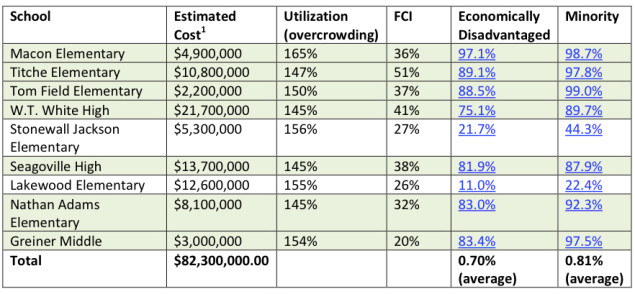It’s spring break, so I’m going to highlight some other voices this week, and I hope I can convince them to keep contributing to Learning Curve in the future. They offer a boots-on-the-ground perspective from different corners of the city. Each of them are DISD parents or contemplating becoming so. Each is actively involved in his or her school(s). First, I’m going to reprint a letter from Lakewood Elementary parent John Franklin Guild. He sent this letter earlier today to trustees. Spoiler alert: It’s fantastic. I’ve provided a PDF of the Trustee Letter here. Reprint is below.
March 11, 2015
Dear Dallas Independent School District Trustees,
I am writing in support of the interim bridge plan, and ultimately, the comprehensive plan. My son is about to start at Lakewood Elementary next year. Sharon Grigsby recently highlighted my wife’s blog post about our decision to commit to public schools. Sharon was right, “Dallas needs more Heather Guilds.” It was a nice write-up, and my wife deserves all the props in the world for everything she does. Heather has walked the walk in ways that most people will never know. We do not even have a child in the DISD yet, but she has already put in hundreds of hours for the early childhood PTA, which raised more than $150,000 for Lakewood, Long, and Woodrow last year alone, thanks in part to an auction she co-chaired. And she wasn’t alone. Lots of people in the neighborhood contributed a lot of time to the cause. I can’t say the same. This letter is just my first step as I try to live up to the example set by my wife.
The problem at the DISD is that the divisiveness causes us to doubt that we are in this together.
I am lost when I consider what I should do to help our public schools. I recently attended the March 5, 2015 board meeting, which reinforced my view that the toxic atmosphere among the board members, reform advocates, reform opponents, teachers, and parents puts in jeopardy any effort to improve the district. The reason is simple: Divisiveness gives everyone an excuse to say no to any amount of personal sacrifice, even when the only way forward is to say yes. Not every positive step taken by the DISD can benefit all 160,000 students at once, but each step requires us all to sacrifice, trusting that ultimately all our children’s health, safety, and educational needs will be met. If we don’t trust that we are all in this together and that our sacrifices will ultimately come back in the form of shared benefits, there can be no progress.
This problem expresses itself in many ways throughout the DISD, but most relevant to this letter is how it affects my community’s faith that the DISD cares as much as our children as we care about public education. For decades, the DISD has relied on the Lakewood community’s trust that its investment in other facilities throughout the DISD would eventually be reciprocated. Unfortunately, the DISD continues to test that trust as we have watched our own elementary school burst at the seams without needed improvements or even adequate maintenance. We have now reached the point that that the DISD risks irrevocably breaking Lakewood’s trust, and with it, Lakewood’s continued support of the vast needs of the DISD.
Why I support the interim bridge plan.
I support the interim bridge plan. But I won’t pretend that my support isn’t influenced by self-interest on my part. Lakewood Elementary desperately needs an expansion and significant maintenance and improvement. The interim bridge plan gets that under way so that my son might benefit rather than spending six years at what everyone agrees is among the worst facilities in the DISD, even if not everyone agrees that it is among the nine worst campuses (it was ranked as have the seventh-greatest need by the administration). In other words, supporting this plan requires no faith or trust on my part — I know that my child directly benefits.
Being self-aware of my bias has forced me to wonder what I would think of this plan if my child were going to one of the many schools also in need of repair that will have to wait for the comprehensive plan. Would I also think it a no-brainer? Should the fact that Lakewood kids predominately live in comfortable homes with educated parents make a difference when deciding how to allocate the DISD’s extremely limited resources? I might get run out of my own neighborhood, or even my own house, for writing this, but I think these are legitimate questions that should be answered. I just think the answers ultimately support the interim bridge plan.
Why the interim bridge plan should be supported by every person who cares about educating poor kids in the DISD: Does anyone doubt the need to expand pre-K?
I am very disappointed that the interim bridge plan has, as far as the press is concerned, turned into a referendum on whether Lakewood Elementary deserves expansion (discussed below), which is less than 10 percent of the plan. The interim bridge plan is so much more, and from my perspective that starts with pre-K. I have not heard any dissent on the basic principle that this is the area where the DISD has the greatest hope in improving outcomes among the groups that have the most significant challenges within the DISD.
The problem is that there isn’t much dedicated funding for pre-K because that is not how schools are funded in Texas (there is some great legislation proposed to help). For now, the most the DISD can offer are some small but important steps in the hope that more are coming. More than $30,000,000 of the proposed funding goes directly into early childhood programs that will directly benefit only the poorest students in the DISD.
It is sad that the press has expressed little interest in this issue. The expansion of pre-K alone should merit passing the interim bridge plan. Indeed, much of the questioning I heard at the meeting entirely ignored pre-K, except some good questions from Lew Blackburn.
Pre-K expansion is an obvious response to dispel the divisive allegations that the interim bridge plan is some type of regression to the bad old days of the DISD favoring predominately white, middle- class schools over predominately minority, poor schools. For the foreseeable future, pre-K is a program that is almost entirely focused on poor, minority children. Everything about pre-K expansion targets those most in need.
Should the DISD care about the facilities at schools that middle-class kids attend?
Yes. Because the DISD should care about the health, safety, and welfare of every child in the district. Because people trust the DISD with their babies, and that trust cannot be ignored simply because those parents are middle or upper class. Because health and safety needs are equal across all socioeconomic groups, and those needs are not being met at Lakewood Elementary. In short, if a trustee thinks it is okay to ignore the circumstances at Lakewood Elementary simply because the kids come from wealthier families, then that trustee has no business doing anything remotely related to the welfare of children.
That does not mean that we do not understand the concerns of some about the limited resources of parents in other communities. I originally started with the question, “Should the fact that Lakewood kids predominately live in comfortable homes with educated parents make a difference when deciding how to allocate the DISD’s extremely limited resources?” I think the answer to that question is yes. The DISD should care, and I believe that most of the families in my neighborhood get that.
That is why Lakewood has historically supported bond programs that repeatedly passed over Lakewood Elementary but made significant improvements to schools throughout the DISD, including the 2008 bond package that focused almost entirely on the southern sector. That is why we have paid property taxes that flow out of our neighborhood to benefit schools in neighborhoods that have less ability to contribute. That is why we continue to be committed to public education in the DISD.
My continued commitment to a public education system that gives every child a chance at a quality education is one reason why I so strongly support the pre-K plan included in the bridge plan. It addresses a specific need, one not shared in equal proportion across communities, and it does it in a way that might help to close the achievement gap in the DISD.
But our historical and continued support of public education cannot excuse the DISD’s failure to take proper care of the children who attend Lakewood Elementary. We have now reached the point where it is unconscionable not to follow through on the desperately needed expansion and renovations included in the interim bridge plan.
The proposed list of schools does not unfairly benefit middle class or white students.
While I hope it is agreed that the DISD should care about the health and safety of middle class students as much as it does poor students, there still is the question of whether this plan reaches the school facilities that are in the most need of repairs and expansion. It is a fair question, particularly for anyone with long enough a memory. But more recent history also needs to be considered. In the past thirteen years, the DISD has focused the vast majority of its resources in both the $1.37 billion 2002 bond program and the $1.35 billion 2008 bond program on economically disadvantaged areas, deferring almost entirely the needs of Lakewood Elementary.
It also ignores the demographics of the schools at issue. Aside from Stonewall Jackson and Lakewood Elementary, all of the other schools selected for significant renovations or expansion under the interim bridge plan serve a population of students that is mostly poor and minority.

Is the formula used by the administration to identify priority schools perfect? Probably not. No formula is perfect. But it is a rational approach that focuses on actual facilities using objective criteria. This alone should give everyone in the DISD more confidence in the DISD’s stewardship of our tax dollars.
I am concerned about suggestions by some trustees that the DISD should only prioritize its largest campuses, forever relegating small schools like Lakewood Elementary to crumble until they no longer exist. Not only does the approach arbitrarily punish children simply because they attend older campuses built when schools were smaller, but it also arbitrarily punishes the youngest students in the DISD.
The argument seems to be that if a 4000-student campus has 10 percent of its facilities in portables, this will always be a priority over an 800-student campus with 33 percent of its facilities in portables because 10 percent of 4000 is greater than 33 percent of 800. If the DISD takes this approach to prioritizing schools and ignores qualitative differences between the facilities, an approach that resulted in Lakewood Elementary being passed over in more than $2.7 billion of bond programs over the past 13 years, then the DISD has effectively decided that the health, safety and welfare of students at Lakewood Elementary do not matter because Lakewood Elementary will always be among the smallest campuses, especially if it does not get the very necessary expansion provided for under the interim bridge plan.
This approach also ignores significant qualitative differences between schools: (1) it is far more harmful to put a child into a 40-year-old portable with mold and other health issues than it is put a child into a recently installed portable; (2) it is far more harmful for an student to spend six hours a day in a portable for a full two or three formative years, years when the child learns to love or hate education, than it is for a high school student to spend one of multiple periods in a portable while spending the majority of the time each and every day in other facilities; and (3) portable buildings present significant safety issues to younger children not present for older children.
Finally, this approach ensures that older schools will not be maintained because they will always be smaller and there will always be limited resources. Ultimately, the DISD will be forced to replace our historical schools rather than repairing and expanding them. This would deprive the DISD of one of its great historical legacies in favor of what are effectively disposable campuses.
A call to validate Lakewood’s longstanding trust in the DISD, and my commitment to respond in kind.
We all have to acknowledge that there are many difficult issues faced by the DISD, not all the DISD’s problems can be tackled at once, and as a result we have to trust each other enough to sacrifice for the common good even when there is no direct personal benefit. For the past two decades, Lakewood has watched as schools throughout the DISD were built, remodeled, expanded, or otherwise improved using bonds supported by the Lakewood community. We have done so patiently, and more recently, impatiently.
All is not lost. We know that Lakewood has not yet lost faith in public schools as evidenced by the fact that we have given $500,000 of our own money to draw up the plans for an expansion. But I do not know how much longer we can keep that faith if the DISD continues to neglect our school and children. If you oppose this plan because our children are not disadvantaged, that tells us that we really are not in it together. It tells us that the DISD would like us to support public education for all, but when it comes to our own children, we need to fend for ourselves because we can. I do not believe the damage to the relationship between our community and the DISD could ever recover.
I know what voting for this requires of you. Each of you has needs within your own communities, and some of those needs are not addressed by the interim bridge plan. Supporting this plan probably requires you to have faith that the Lakewood community will continue to support projects around the DISD after work at our school is underway, the same type of faith Lakewood has had to show in the DISD during the past twenty years. I am asking you to decide that we are all in this together and to support the interim bridge plan. If our urgent needs are addressed, I have faith that Lakewood will continue to be there for every kid in the DISD. I know I will be there for them with you.
Very truly yours,
John Franklin Guild







